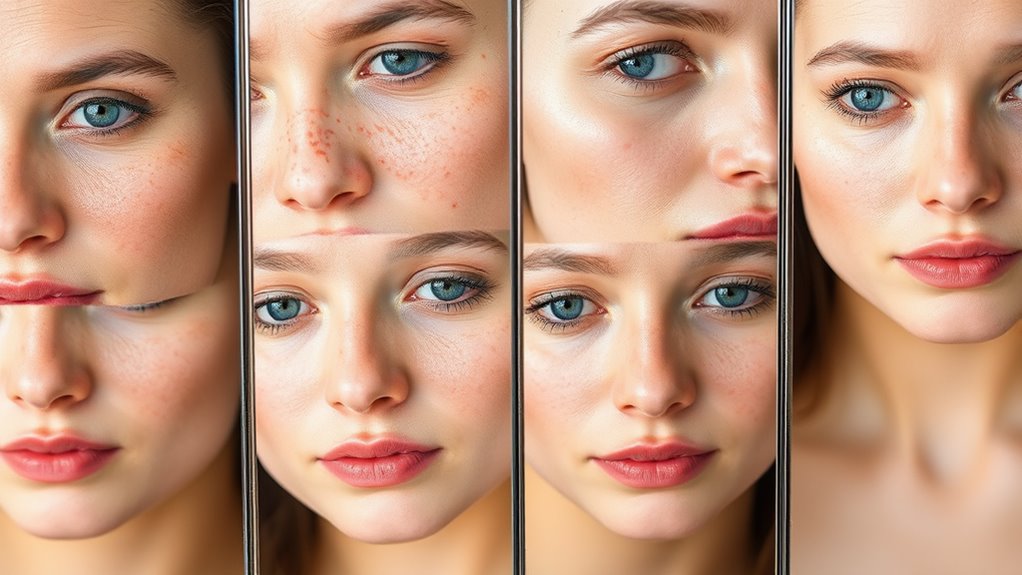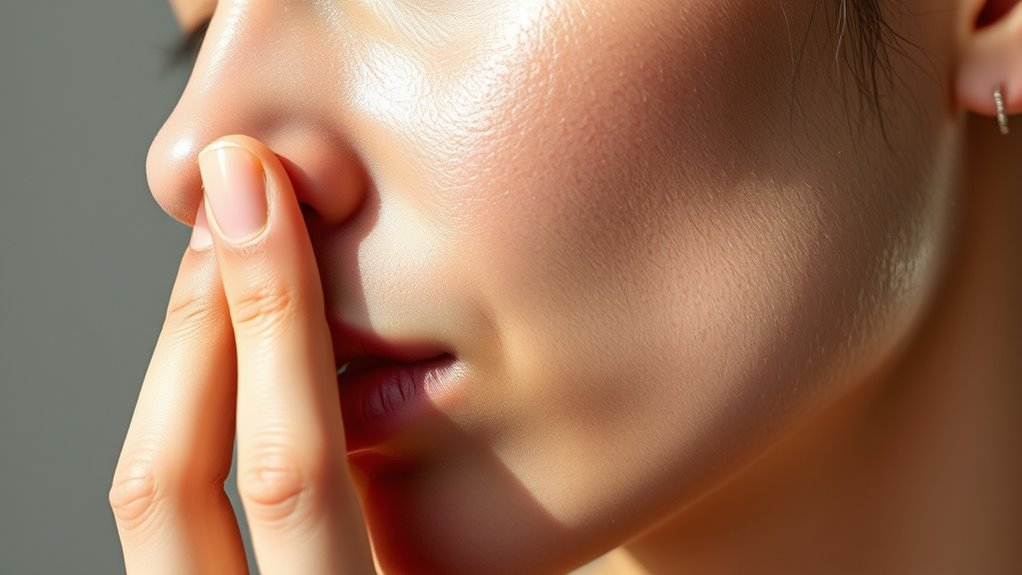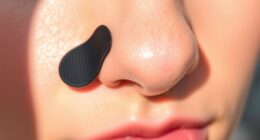Understanding your skin type is key to choosing the right products and creating an effective skincare routine. Start by doing a simple test: wash your face, wait an hour, then observe how your skin feels and looks. Notice if it’s oily, dry, sensitive, or a mix of these. Recognizing these signs helps you address specific concerns and improve your skin’s health. Keep exploring to learn how to tailor your routine perfectly to your skin’s needs.
Key Takeaways
- Identify your skin type through simple at-home tests like observing shininess or tightness after washing.
- Recognize characteristics such as oiliness, dryness, sensitivity, or combination patterns across different areas.
- Understand that dry skin feels rough and dull, while dehydrated skin results from moisture loss, not oil deficiency.
- Monitor for signs of sensitivity, like redness or irritation, to determine if your skin reacts to environmental or product triggers.
- Tailor skincare routines based on your skin type to maintain proper hydration, balance oil production, and protect the skin barrier.
Recognizing the Main Skin Types

Have you ever wondered how to identify your skin type? Understanding your skin begins with recognizing its main types—oily, dry, combination, and sensitive. Your skin microbiome, the collection of microorganisms living on your skin, influences these types and how your skin reacts. For instance, an imbalance in your microbiome can lead to issues like excess oil production or dryness. Additionally, your skin type affects pigmentation issues; oily skin may be prone to acne scars, while dry skin often shows dullness or uneven tone. Observing how your skin feels and looks throughout the day helps you pinpoint your type. Recognizing these main skin types allows you to tailor your skincare routine effectively and address specific concerns like pigmentation issues more precisely. The skin microbiome plays a crucial role in maintaining overall skin health and can impact how your skin responds to different products and treatments.
Conducting a Simple Skin Test at Home

To accurately identify your skin type, performing a simple test at home can be highly effective. Start by washing your face with a gentle cleanser and pat it dry. Leave your skin bare for about an hour, allowing your skin barrier to settle. Afterward, observe how your skin feels: if it appears shiny and feels greasy, you likely have oily skin; if it feels tight or dry, you may have dry skin. Normal skin will feel comfortable, while sensitive skin might react with redness or irritation. This test also helps you understand how your skin ages—whether it’s showing signs of dullness or fine lines, which can indicate a compromised skin barrier. Regularly monitoring your skin helps tailor your skincare, promoting a healthier, more resilient complexion. Additionally, understanding your skin type can help you make informed choices about skincare products and treatments suited to your unique needs. Knowing your skin type can also guide you in choosing the right ingredients for your routine, such as those that support skin barrier health.
Identifying Oily Skin Characteristics

If you notice that your skin tends to look shiny throughout the day and feels greasy to the touch, you likely have oily skin. This oiliness causes your pores to appear enlarged and may lead to a buildup of sebum, the skin’s natural oil. Excess sebum production is often triggered by hormonal changes, genetics, or environmental factors. You might also notice blackheads, whiteheads, or acne breakouts more frequently. Oily skin tends to be more prone to shine, especially in the T-zone area—forehead, nose, and chin—by midday. Recognizing these characteristics helps you understand your skin’s oiliness causes and how to manage sebum production effectively. Keeping your skin clean and using appropriate products can help control excess oil and maintain a balanced complexion. Fostering a digital-friendly environment at home can also support overall skin health by reducing exposure to environmental pollutants. Incorporating consistent skincare routines tailored for oily skin can further improve your skin’s appearance and health. Being aware of hormonal influences can help you better understand fluctuations in oil production and manage breakouts more effectively. Additionally, consulting with a female divorce attorney or a dermatologist experienced in skin conditions can provide personalized strategies for better management.
Spotting Dry and Dehydrated Skin Signs

Dry and dehydrated skin often show visible signs, making it easier to distinguish between the two. With dry skin, your hydration levels are naturally low, leading to a rough, flaky texture and dull appearance. You might notice tightness, especially after cleansing, and your skin may feel uncomfortable or itchy. Dehydrated skin, on the other hand, occurs when your skin loses moisture due to environmental factors, skincare habits, or lifestyle choices. It can appear dull, look flaky, and feel tight, but the underlying cause is moisture loss rather than a lack of oil. To spot these signs, pay attention to how your skin reacts throughout the day. Proper hydration and moisture retention are key to maintaining healthy, balanced skin and preventing further dryness. Additionally, using hydrating products that support moisture retention can make a significant difference in managing these conditions effectively. Recognizing the difference can help you adopt the right skincare routine to address your specific skin needs.
Understanding Sensitive Skin Triggers

You may find that certain irritants or allergens in your environment or products trigger your sensitive skin. Environmental factors like pollution or extreme weather can also cause reactions, making it harder to keep your skin calm. Identifying these triggers helps you choose gentle products and protect your skin effectively. Additionally, understanding indoor air quality and maintaining a clean environment can further reduce skin irritation caused by airborne pollutants. Incorporating skin barrier protection strategies can also help minimize the impact of external aggressors on sensitive skin. Recognizing how contrast ratio influences overall image quality can guide you in selecting the right projector for your home cinema setup. Being aware of environmental influences such as humidity and temperature fluctuations can further aid in managing sensitive skin reactions.
Common Irritants and Allergens
Sensitive skin can react quickly to certain irritants and allergens, making it important to recognize common triggers. Fragrance allergens are a frequent culprit, often found in perfumes, scented lotions, and cleansers, causing redness and irritation. Skincare preservatives, like parabens and formaldehyde releasers, can also provoke allergic responses or irritation, especially in sensitive skin. These substances are added to extend product shelf life but may compromise your skin’s barrier. Other common irritants include harsh soaps, alcohol-based products, and certain dyes. Being aware of these triggers helps you avoid products that could worsen your skin condition. Always check ingredient labels carefully and opt for fragrance-free, preservative-free options when possible. Recognizing these irritants is the first step toward healthier, calmer skin. Additionally, using products like Pimple Patches can help protect your skin while treating blemishes, minimizing further irritation.
Environmental Factors Impacting Skin
Environmental factors can substantially trigger sensitive skin reactions, often catching you off guard. Pollution effects, such as airborne toxins and dirt, can irritate your skin, leading to redness and inflammation. These pollutants create oxidative stress, weakening your skin’s natural barrier and making it more reactive. UV radiation from the sun is another major factor; it accelerates skin aging and causes sunburns, especially if your skin is already sensitive. Constant exposure can increase irritation and worsen existing conditions. Protecting yourself with broad-spectrum sunscreen, wearing protective clothing, and avoiding prolonged sun exposure can help reduce these effects. Additionally, staying indoors during high pollution days or using air purifiers can minimize your skin’s contact with harmful particles. Recognizing these environmental triggers empowers you to better care for your sensitive skin. Understanding the role of AI in cybersecurity and other sectors can also help you stay informed about innovative safety measures that protect personal data, including your health information, from potential risks. Incorporating advanced pollution monitoring technologies can further assist in managing exposure to environmental irritants and safeguarding your skin health.
Personal Care Product Sensitivities
Environmental pollutants can compromise your skin’s health, but personal care products also play a significant role in triggering reactions. Ingredient sensitivities often cause irritation, redness, or breakouts, especially if you use products with harsh chemicals. To minimize these reactions, always read product ingredient labels carefully. Look for common irritants like alcohol, fragrances, or sulfates, and avoid them if you notice sensitivity. Sensitive skin can react even to products marketed as gentle, so patch-test new items first. Choosing products formulated for sensitive skin and containing soothing ingredients like aloe or oatmeal can help reduce triggers. Being vigilant about ingredient sensitivities and understanding product labels empowers you to select skincare that protects your skin’s health while avoiding uncomfortable reactions. Recognizing the importance of Ingredient sensitivities can further help you make informed choices and maintain healthier skin.
Recognizing Combination Skin Traits

If you notice your forehead, nose, or chin are oilier than your cheeks, you might have combination skin. At the same time, your cheeks could feel dry or flaky, highlighting the uneven texture. Recognizing these traits helps you choose the right skincare to balance your skin effectively.
T-zone Oiliness
Many people with combination skin notice that their T-zone—forehead, nose, and chin—tends to be oilier than the rest of their face. This occurs because the oil production in this area is higher, leading to a shinier appearance and more visible pore size. The increased pore size makes it easier for excess oil to accumulate, which can contribute to breakouts and a greasy feel. You might find that your cheeks remain relatively dry or normal, but your T-zone constantly looks shiny or feels greasy by midday. Recognizing this trait helps you choose skincare products that control oiliness without over-drying other areas. Balancing oil production across your face is key to managing T-zone oiliness and maintaining a healthy, shine-free complexion.
Dry Cheek Areas
While your T-zone may be prone to excess oil, your cheeks might tell a different story—they can feel dry, tight, or flaky. Recognizing these dry cheek areas helps identify combination skin traits. To keep your skin balanced, choose moisturizer recommendations that are hydrating but not greasy, like those with hyaluronic acid or glycerin. Regular, gentle exfoliation techniques, such as using a mild scrub or chemical exfoliant, can remove dead skin cells and improve absorption of moisturizers. Be careful not to over-exfoliate, as this can worsen dryness. Focus on nourishing your cheeks with products designed for dry skin, and use lighter formulas on oilier areas. This approach helps maintain a healthy, even complexion across your face.
Tips for Maintaining Your Skin Type

Maintaining your skin type requires consistent care tailored to its specific needs. Start by choosing skincare ingredients that suit your skin, whether it’s hydrating hyaluronic acid for dry skin or oil-controlling salicylic acid for oily skin. Use gentle cleansers that don’t strip natural oils, and incorporate moisturizers that reinforce your skin’s barrier. Sun protection is essential; apply broad-spectrum sunscreen daily to prevent damage and maintain your skin’s health. Avoid harsh products that can upset your skin’s balance, and always read labels to ensure ingredients align with your skin type. Consistency is key—stick to a routine that respects your skin’s unique requirements. By doing so, you’ll help preserve your skin’s natural balance and keep it looking healthy and vibrant.
Adjusting Your Skincare Routine Over Time

As your skin changes due to factors like aging, seasonal shifts, or lifestyle adjustments, it’s important to update your skincare routine accordingly. Adapting routines helps address new needs, prevent issues, and keep your skin healthy. During seasonal changes, you might need richer moisturizers in winter or lighter formulas in summer. Pay attention to how your skin responds and adjust products or routines as needed. For example, if your skin feels drier in colder months, incorporate hydrating serums or oils. Conversely, if it becomes oilier in warmer weather, switch to oil-free or mattifying products. Regularly reassessing your skincare ensures your routine remains effective and tailored to your current skin condition, helping you maintain a radiant, balanced complexion year-round.
Frequently Asked Questions
How Often Should I Reassess My Skin Type?
You should reexamine your skin type every few months or when you notice changes in your skin’s appearance. Performing a skin assessment helps you determine if your current skincare routine still works or needs adjustments. As your skin evolves due to seasons, age, or lifestyle, regular evaluation ensures you’re using the right products. Keep an eye on how your skin feels and looks to maintain a healthy, effective skincare routine.
Can My Skin Type Change Over the Years?
Your skin type can definitely change over the years, much like how aging skin evolves. While you might start with oily or dry skin, factors like hormones, climate, and lifestyle can lead to a skin type evolution. Aging skin can become drier or more sensitive. So, it’s important to reassess regularly, as what worked before might not suit your current skin needs. Keep adapting your routine accordingly.
What Ingredients Are Best for Sensitive Skin?
For sensitive skin, you want gentle cleansers that won’t cause irritation. Look for soothing ingredients like aloe vera, chamomile, and oat extract, which calm and protect your skin. Avoid harsh chemicals, fragrances, and alcohol, as they can trigger reactions. Stick to these gentle, soothing ingredients to maintain healthy, comfortable skin, and always patch-test new products to confirm they suit your sensitive skin.
How Do Hormones Affect My Skin Type?
Hormonal fluctuations can markedly impact your skin type by causing changes in oil production, leading to breakouts or dryness. These fluctuations affect your skin’s elasticity, making it more prone to sagging or dullness. You might notice your skin feeling different at various times, especially during hormonal shifts like PMS or menopause. By understanding these effects, you can adjust your skincare routine to better support your skin’s health and resilience.
Is There a Permanent Way to Determine My Skin Type?
You can’t always judge a book by its cover, but a skin analysis and dermatologist consultation are your best bets for a permanent answer. These professionals can assess your skin’s unique traits with precision, helping you identify your true skin type. While at-home tests can be helpful, they’re not foolproof. Investing in expert advice guarantees you get accurate, lasting results and tailored skincare routines that work for you.
Conclusion
Knowing your skin type helps you choose the right products and avoid costly mistakes. Did you know that about 50% of people worldwide struggle with sensitive skin, making it one of the most common concerns? By understanding your skin’s unique traits, you’ll better address its needs and maintain a healthy, glowing complexion. Keep testing, adjusting, and caring for your skin—your best skin is within reach when you know what it truly needs.









